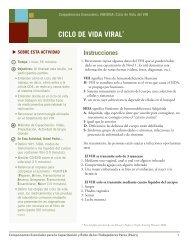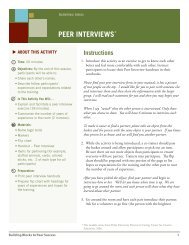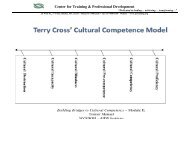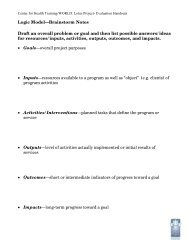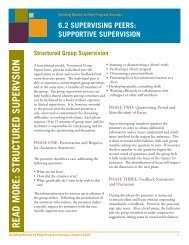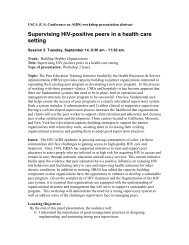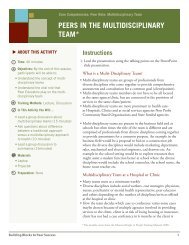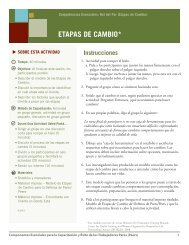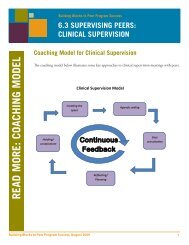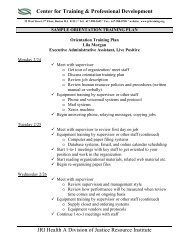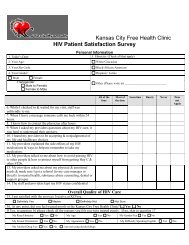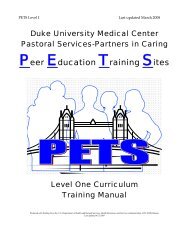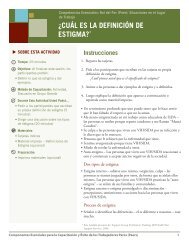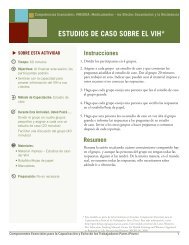Communication Skills - Peer Education & Evaluation Resource Center
Communication Skills - Peer Education & Evaluation Resource Center
Communication Skills - Peer Education & Evaluation Resource Center
Create successful ePaper yourself
Turn your PDF publications into a flip-book with our unique Google optimized e-Paper software.
COMMUNICATION SKILLS<br />
25. The next skill is Express Thoughts and<br />
Feelings. Ask: How do we do that<br />
• Be open and honest – this will help build trust.<br />
• Speak clearly - don’t mumble and don’t talk too<br />
quietly. If you don’t know the word for something,<br />
describe what you mean so that you and the client<br />
can have a shared understanding of your concern<br />
or question.<br />
• Make the distinction between facts, beliefs, and<br />
feelings. For example, which of the following<br />
statements are which<br />
“Te best medical regimen for all clients is …”<br />
(belief)<br />
“I’m so pleased you’ve been taking your meds.”<br />
(feeling)<br />
“Most PLWH experience …” (fact)<br />
26. The last skill is to communicate without<br />
making other feel “Wrong”. How do we do<br />
this<br />
• Express concerns non-judgmentally - talk about<br />
your questions or concerns without blaming other<br />
people. For example, you might be angry that<br />
your client stood you up three times in a row.<br />
Rather than talk about her being irresponsible,<br />
you can ask her what stopped her from showing<br />
up.<br />
27. Now we are going to practice some of these skills.<br />
28. Break up group into pairs. Using Barbara’s case study<br />
as a skit, ask each pair to practice each of the following<br />
communication skills with your partner. One person is<br />
Barbara and one person is Sonya.<br />
29. Barbara will talk to Sonya to get more information<br />
about her situation and how she might go about<br />
helping her. Give pairs 20 minutes. Ask them to<br />
switch roles 10 minutes into the exercise.<br />
• Ask open ended questions.<br />
• Respond with affirming statements.<br />
• Active Listening- Reflect back what the person said.<br />
• Nonverbal Messages<br />
• Express Toughts and Feelings<br />
• Communicate without making the other feel wrong.<br />
30. Sonya should give feedback to Barbara about her use<br />
of the communication skills. 5 minutes<br />
31. Have the pairs report back on how easy or difficult it<br />
was to use the communication skills.<br />
Summary<br />
• Using these skills will feel artificial and awkward at first,<br />
but with practice, they come more easily.<br />
• Practice, practice, practice! Practicing with children is<br />
great, since you’re less likely to be self-conscious.<br />
• Use “I” statements. Rather than say, “You didn’t<br />
explain that very well,” say, “I didn’t understand<br />
what you just said. Please explain it again.”<br />
* Tis module is part of the online toolkit Building Blocks to <strong>Peer</strong> Success. For more<br />
information, visit http://www.hdwg.org/peer_center/training_toolkit.<br />
Tis module comes from the Lotus Women’s <strong>Peer</strong> <strong>Education</strong> Training Manual, <strong>Center</strong><br />
for Health Training and Women Organized to Respond to Life Treatening Diseases<br />
(WORLD), 2008.<br />
Building Blocks to <strong>Peer</strong> Success 4



